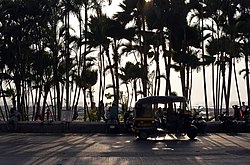Khar | |
|---|---|
suburb | |
 Northern end of the Carter Road Promenade at Khar West | |
| Coordinates: 19°04′N 72°50′E / 19.067°N 72.833°E | |
| Country | India |
| State | Maharashtra |
| District | Mumbai Suburban |
| City | Mumbai |
| Government | |
| • Type | Municipal Corporation |
| • Body | Brihanmumbai Municipal Corporation (MCGM) |
| Languages | |
| • Official | Marathi |
| Time zone | UTC+5:30 (IST) |
| PIN | 400052 |
| Area code | 022 |
| Civic agency | BMC |

Khar (Marathi pronunciation: [kʰaːɾ]) is an affluent suburb of Mumbai, north of Bandra and south of Santacruz, Mumbai. Originally one of the 'villages' that made up the larger Bandra, the present suburb is divided into Khar West and Khar East areas. It is serviced by Khar Road railway station of the Mumbai Suburban Railway network. It is an area within convenient distances of several schools, restaurants, parks, promenades and shopping centres. Khar bears the Mumbai Postal Index Number (Pin Code) 400052.
Khar, which is derived from the word Khāra (meaning 'salty' in the local language Marathi) has acquired this name in reference to the salt pans that were used to farm salt by locals near the Khar Danda sea shore a couple of centuries ago. Here, one also finds the historic fishing village of "Khar Danda", which is one of the villages that made up the original Bandra area and is also one of the oldest settlements of Mumbai.[1]
History[edit]

Most of the historic Khar area of Bandra was a marshland of salty sea water.[citation needed] Alongside fishing, salt production was one of the vocations that sustained the earliest dwellers of Khar Danda.
Pathare Prabhus were one of the earliest inhabitants of Khar, from almost a century and half ago. In the early 1900s, the Pathare Prabhu community lived in South Mumbai and used their quaint bungalows in Khar as weekend dwellings. Khar Danda was one of the original villages of the erstwhile larger Bandra. Back then, the local Bandra railway station was felt distant to alight from trains and hire 'tangas' (horse carriages) to get to these bungalows in the Khar part of Bandra. Keeping these factors in mind, as well as the growing number of homes in this part, a second railway station named 'Khar Road' was introduced in north Bandra on 1 July 1924. This development is the primary reason for Khar to start being spoken of as a suburb by itself.[2] The Pathare Prabhu community still has land ownership over a large area of Bandra/Khar.
Schools and colleges[edit]
Following are the educational institutions located at Khar:
- Podar International School (IB & CAIE)
- Khar Municipal School
- ST Elias High School
- B.P.M. High School
- Sacred Heart Boys School
- Khar Education Society's College of Commerce & Economics.
- M.M. Pupils
- Kamla High School and Jr. College
- Bloomingdales Pre-primary / Jasudben M. L. School (ICSE)
- R.V. Technical high School
- Guru Nanak Mission High School[3]
- Beacon High
- Anuyog Vidyalaya
- Cardinal Gracious High School
Religious places[edit]
- Shankar Mandir
- Maruai Devi Mandir
- Shree Siddhivinayak Devastan
- Digamber Jain Temple
- Ahimsa Bhawan Jain Sthanak on 14A Road
- Jain Temple at 5th Road
- St. Vincent De Paul Church, Khar
- Ghanteshwar Temple Mumbai, Khar west
- Gayatri Mandir 12th Road Khar west
- Ram Mandir 12th Road Khar west
- Rama Krishna Mission 12th Road Khar west
- Guru Gangeshwar Dham 6th Road Khar west
- Khatwari Darbar Linking Road Khar west
- Shri Guru Singh Sabha Gurudwara Station Road Khar west
- Khar Markaz Masjid Old Khar Khar west
- Shri Aniruddha Gurukshetram, Old Khar
Medical facilities[edit]
- Hinduja Healthcare Surgical
- Mahavir Hospital on Ahimsa Marg (14A Road)
- Ram krishna mission hospital
- Beams Hospital 18A Road Khar west
Notable residents[edit]
- Asha Bhosle, Indian playback singer
- Anu Malik, Indian music director
- Gulzar, Indian lyricist
- S.D.Burman, Indian musician
- Suman Kalyanpur, Indian playback singer
- R.D.Burman, Indian music director
- Tiger Shroff, Indian actor
See also[edit]
References[edit]
- ^ "Khar Danda | KharWest.com - Khar West Local News". Archived from the original on 10 November 2013. Retrieved 27 April 2020.
- ^ "Mumbai's Khar Station Turns 90". ndtv.com. Retrieved 1 July 2014.
- ^ "Gurunanak Mission High School, Mumbai - Admissions, Address, Reviews and Fees 2022". iCBSE.



Well, that’s interesting to know that Psilotum nudum are known as whisk ferns. Psilotum nudum is the commoner species of the two. While the P. flaccidum is a rare species and is found in the tropical islands. Both the species are usually epiphytic in habit and grow upon tree ferns. These species may also be terrestrial and grow in humus or in the crevices of the rocks.
View the detailed Guide of Psilotum nudum: Detailed Study Of Psilotum Nudum (Whisk Fern), Classification, Anatomy, Reproduction